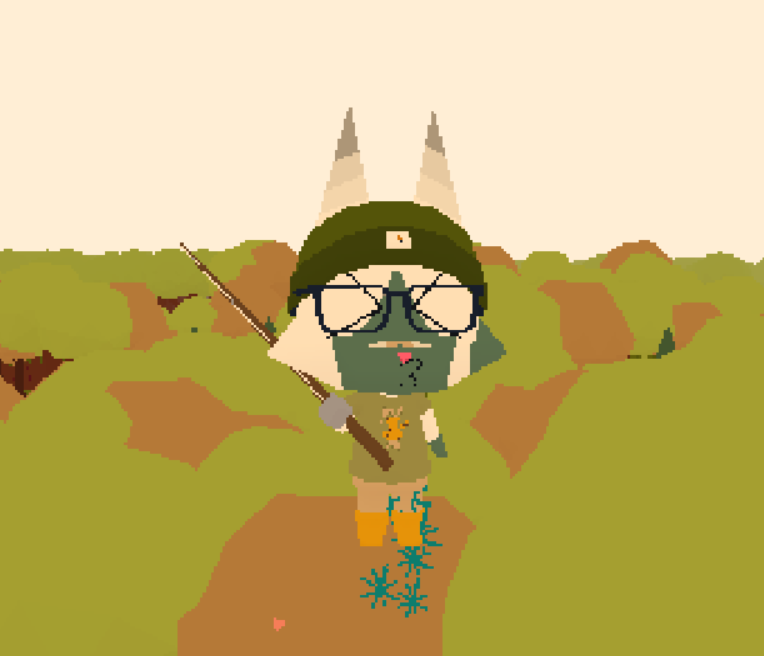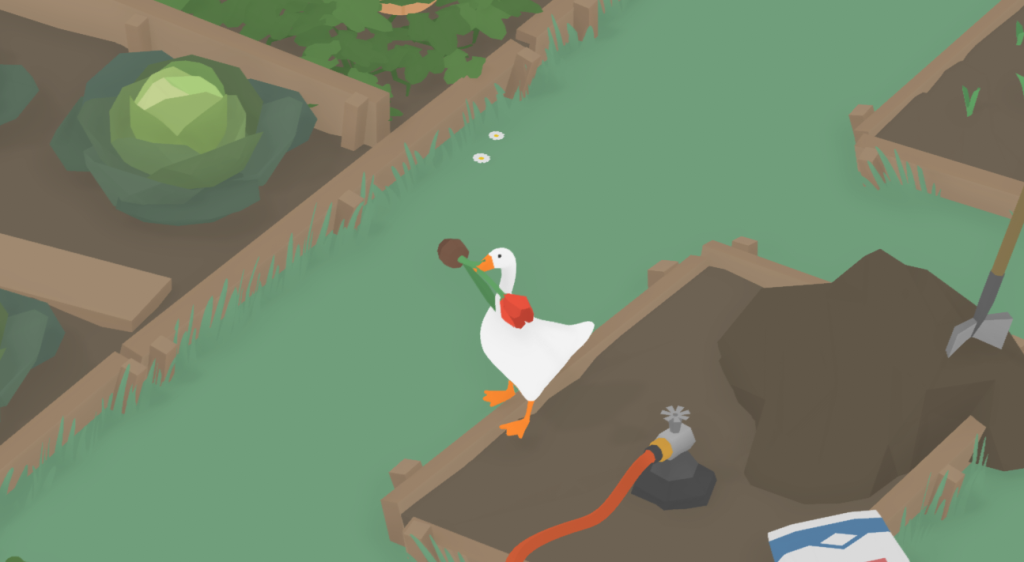A compilation of Games reviewed for this project that is relevant to the desired user experience of Oh, Rats!
Colour-coded inspirations for my game:
- Aesthetics: Look & feel
- Mechanics: Rules, procedures, Game loop
- Story: Sequence of events
Webfishing

Main Inspiration for my game: Graphics / Multiplayer
Webfishing is a “multiplayer chatroom-focused fishing game” (as described by its developer) where the goal is to fish and make friends! I got this game as a gift for my birthday, and I’ve only played it a few times, but it has a wonderful community surrounding it. The game is like if you mixed Animal Crossing with a classic 00s MMO where you can chat with strangers about random subjects while you go about your quests.
The game has unlimited playtime, you can hop on a server (or make your own) and go whenever you’d like. There isn’t a particular goal other than “collect as many fish as you can” if you’re a completionist! I’m currently on Rank 10, nearly 11 and the thrill of trying to catch those massive fish that people find is what draws me into casting my rod again and again.
For this review, I made a webfishing server for people to join. The server at its busiest was only 4 people, but it provided for a lot of wacky and silly convos to be had. This game simulates what it would be like to fish with other people in real life, casting your rod and making small conversation until you feel your rod getting tugged at and eagerly await your prize as you reel up your fish. The game has a simple system of rewarding you selling your fish with money, and money so you can customise your character further. There are a lot of quirky items to collect in this game: titles, shirts, a top hat, and even an in-game guitar that simulates real guitar playing!
With my avatar, dressed as a typical American high school dork, I can roam around the area and appreciate the scenery while talking to cool people! I love the pixelated art style of this game, it makes it super nostalgic to play. You can turn off pixelation, but I like the “roughness” it gives to the game, akin to putting on your nostalgia glasses. Overall, it’s pretty great! I can easily spend 1-2 hours just fishing, talking and completing mini-quests for money. It does what it says on the tin and I think that’s what drew so many people to it.
Relating this to my game, I like the idea of a multiplayer lobby, and I would love to incorporate a multiplayer feature for my game in an ideal world where I’d know how to code that. I’d love players to be able to interact with other rats, trade and band together to fight enemies. I’m also taking notes on the customisation and style of the game. For one, the customisation is great, there are so many combos for your character to wear and everyone’s character looks unique to them. I want my game to be like this where players are encouraged to try on new looks and upgrades. Secondly, while a minor part of the game, I love the OST! It is inspired by Animal Crossing, and it does it well. It’s simple, sweet yet cosy like a warm hug in winter. Opening up the main theme makes me feel so comfy.



Splatoon 3

Main Inspiration for my game: Cutscenes / Lore
Splatoon 3 (SPT 3) was my first proper introduction to the Splatoon (SPT) series. My only other exposure was the first iteration which was sadly a WII U exclusive, a console that I didn’t have. I was super excited when I heard that a new Splatoon game was coming out in 2022!
Splatoon 3 has a solid single-player campaign, a tradition from Splatoon 2’s well-lauded Octo expansion. You play as either an Inkling or Octoling, the game’s main races, defeat the unruly fuzzy Octarians and bring back the Great Zapfish (the source of power for the city). To get to the campaign, you have to slide through a gutter on the side of the city to get to an area called “The Crater” (essentially the tutorial area). After completing this area, you set foot into Alterna, where you discover this desolate place’s secrets and mysteries.
I loved the single-player campaign of this game. The lore was amazing and the game encouraged you to progress through each area unlocking new lore about the previous residents. This area was a huge deal for Splatoon lore and thus an amazing introduction to the series for me. The “sites” of Alterna, as the game calls it, start eerie and rather depressing. The music is scratched, mostly covered in this “fuzzy ooze” that instantly kills you if you go too close, and the other parts are surrounded by water. I felt so confused and a little sad seeing that the life that used to thrive here is long gone. However, through each site, you feel that sense of progression, to keep going and find out what happened. Each site has music vinyls you can find randomly – up to 4 for each site – that change the music drastically.
My favourite site is called Cryogenic Hopetown, whose music starts like a faded, scratched distant memory. Progressing through the site unlocks clearer songs and by the fourth phase, you get a solemn yet warm wintery tune that (if you know the lore) you can feel the hopes, dreams and nostalgia of the former residents. This type of lore and worldbuilding is inspiring for my game. While I don’t want my game to be solemn, I do want to invoke a reaction of curiosity, discovery and change (as per my essential experience). I find SPT 3’s single-player campaign mode to be great at dropping subtle hints at the past and how it leads to the future.
The cutscenes of SPT 3 are great at characterising the personalities of people you meet. My most beloved one in the game is the introduction of Deep Cut, the antagonists of the single-player campaign who try to always get in your way with a boss battle every 2 sites. Their theme is sharp yet steeped in culture and confidence. The team is made up of 3 characters: Frye, Shiver and Big Man. Frye is based on South Asian and Desi culture, Frye is based on traditional Japanese culture, and Big Man is based on Brazilian culture. Their mannerisms are reflected through not only how they act during the cutscene, but also the way their respective cultural instruments are played. The electronic fusion of the instruments also gives it that edge that sets players’ expectations for their role in the game. Through SPT 3, I’ve gained a bit more knowledge on how to introduce characters in a cutscene as well as subtle ways to encourage players to learn more about the lore. I will be applying this knowledge the the human character introductions for each level.
Untitled Goose Game

Main Inspiration: Studying humans’ reactions to animals causing chaos (assigned character personalities)
Untitled Goose Game is an indie puzzle stealth game! I played around with it, and it has a similar vibe to what I want to achieve in my game. The logline is ‘It’s a lovely day in the village and you are a horrible goose’ which is pretty much the entire game. Set in an Idyllic English Village, it’s the perfect setting to cause trouble.
The main goal of the game is to complete your checklist tasks. As a goose, you can take objects from the world, and from humans’ hands. I found this a really fun mechanic as I felt that I was embodying the goose. From honking to annoy the humans, to flapping your wings to seem intimidating, to stealing items and putting them in inconvenient places. This game forces you to think like a malevolent goose with nothing else to do other than terrorise people, which is great for relieving stress. The use of stealth in the game was really important for my research, as to get certain items you need to hide in bushes and distract them from your mayhem. I wasn’t the best at this mechanic, as the garden keeper found me several times when I was hiding in a bush.
Another thing I like about this game is that the humans all have different personalities. It’s something I’ve thought about implementing into my game. The personality systems of the game bring the human characters (and their reactions!) to life. The 4 personalities are: Normal, Tidy, Scaredy and Chaser. Normal villagers chase after you steal their items and put them back. Tidy villagers worry about their items and throw away items that aren’t theirs. Scaredy neighbours get scared if you honk at them multiple times. Chaser villagers will chase you on sight. I think these fun personalities are a way to make these characters believable. You can read about the system I’ve implemented at the bottom of the Gameplay page.
This game taught me a bit about human personalities and how that ties into reactions towards animals causing mischief! In the final version of my game, there would be a proper character personality set-up with specific reactions tied to certain personalities.

